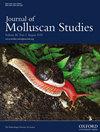A new species of Sakuraeolis from Mozambique, described using 3D reconstruction of anatomy and phylogenetic analysis
IF 1.2
4区 生物学
Q2 MARINE & FRESHWATER BIOLOGY
引用次数: 3
Abstract
Here we describe a new species of shallow-subtidal nudibranch from south-eastern Africa. The strikingly vivid orange sea slug with white markings belongs to the long-disputed family Facelinidae, and has been photographed and recorded in the region by divers for some time. Tomographic modelling was applied to produce a 3D anatomical reconstruction of the reproductive and digestive organs from serial sections. A molecular phylogeny using multiple markers (cytochrome c oxidase subunit I, 16S rRNA and histone H3) recovered three distinct clades within the paraphyletic Facelinidae, in agreement with other recent studies. This topology supported a genus-level clade, including the type species of Sakuraeolis Baba, 1965, S. enosimensis Baba, 1930, the new species described herein, S. arcana n. sp., and an undescribed sibling species that shares morphological resemblance to S. arcana n. sp. Facelina quatrefagesi Vayssière, 1888 is also recognized as Caloria quatrefagesi n. comb. on the basis of molecular and morphology affinity. Field observations provided insight into phenology, with a population decline noted in August. Although the new species does not have the penial structure previously considered diagnostic for Sakuraeolis, the decision was made on the balance of evidence for phylogenetic affinity to amend the diagnosis of the genus to accommodate S. arcana n. sp.一种来自莫桑比克的樱树新种,利用三维解剖重建和系统发育分析进行描述
在这里,我们描述了一种来自非洲东南部的浅潮下裸鳃新种。这种带有白色斑纹的橙色海蛞蝓属于长期存在争议的海蛞蝓科,潜水员在该地区拍摄和记录了一段时间。层析建模应用于产生一个三维解剖重建的生殖和消化器官从一系列的切片。使用多个标记(细胞色素c氧化酶亚基I, 16S rRNA和组蛋白H3)的分子系统发育恢复了副葡萄球菌中三个不同的分支,与其他最近的研究一致。这种拓扑结构支持一个属级进化,包括1965年的Sakuraeolis Baba模式种、1930年的S. enosimensis Baba、本文描述的新种S. arcana n. sp,以及一个未描述的与S. arcana n. sp形态相似的兄弟种。Facelina quatrefagesi vayssi re, 1888年也被认为是Caloria quatrefagesi n. comb。基于分子和形态亲和。野外观察提供了对物候的深入了解,8月份发现了种群数量的下降。虽然新种不具有先前被认为是Sakuraeolis诊断的尖部结构,但在平衡了系统发育亲缘性的证据后,决定修改该属的诊断,以适应S. arcana n. sp。
本文章由计算机程序翻译,如有差异,请以英文原文为准。
求助全文
约1分钟内获得全文
求助全文
来源期刊

Journal of Molluscan Studies
生物-动物学
CiteScore
3.00
自引率
8.30%
发文量
36
审稿时长
3 months
期刊介绍:
The Journal of Molluscan Studies accepts papers on all aspects of the study of molluscs. These include systematics, molecular genetics, palaeontology, ecology, evolution, and physiology. Where the topic is in a specialized field (e.g. parasitology, neurobiology, biochemistry, molecular biology), submissions will still be accepted as long as the mollusc is the principal focus of the study, and not incidental or simply a convenient experimental animal. Papers with a focus on fisheries biology, aquaculture, and control of molluscan pests will be accepted only if they include significant advances in molluscan biology. While systematic papers are encouraged, descriptions of single new taxa will only be considered if they include some ‘added value’, for example in the form of new information on anatomy or distribution, or if they are presented in the context of a systematic revision or phylogenetic analysis of the group.
 求助内容:
求助内容: 应助结果提醒方式:
应助结果提醒方式:


